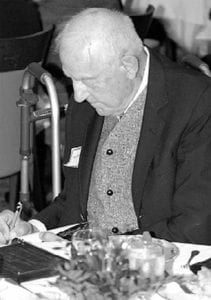IN APPRECIATION • HENRY S. KERNAN
Over Lifetime, Growing Forest
Brought Conservationist Home
Editor’s Note: This appreciation of Henry S. Kernan, 2008 OCCA Conservationist of the Year and author of “The Gifts of a Forest,” was prepared by his grandson. Friends are invited to visit the family 2-5 p.m. Sunday, Oct. 2, at 457 County Highway 40, South Worcester. In recent years, Mr. Kernan resided at Woodside Hall, Cooperstown.

By TED KERNAN
SOUTH WORCESTER – To Henry Sherrill Kernan, a walk through the woods was no mere stroll, but, as naturalist John Muir said, a way into understanding the universe itself. More than a simple desire to be outside motivated his epic ramblings; they were bound up in a deep commitment to learning that led him from the rocky hills of Cyprus to the tropical forests of Borneo.
Perseverance and curiosity were pronounced traits that motivated him to study the languages of the 36 countries where he worked during his long career as a forester. He and his wife raised five children in Iran, Spain, and South Korea, all the while managing a working forest in Upstate New York.
You have reached your limit of 3 free articles
To Continue Reading
Our hard-copy and online publications cover the news of Otsego County by putting the community back into the newspaper. We are funded entirely by advertising and subscriptions. With your support, we continue to offer local, independent reporting that is not influenced by commercial or political ties.

